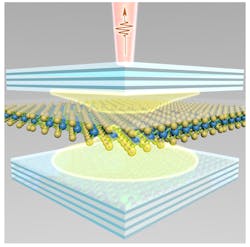A two dimensional (2D) semiconductor material could serve as a platform for new nanolasers, and potentially future quantum applications.
Developed by a team at the University of Oldenburg (Germany) — in conjunction with researchers from the University of Jena (Germany), the University of Würzburg (Germany), Arizona State University, Westlake University (China) and the National Institute for Materials Science in Tsukuba (Japan) — the new material features crystals made up of just three atomic layers is able to emit “laser-like light” at room temperature. This is a first for the field, according to the researchers — previously, this was only possible at “temperatures just above absolute zero.”
"The transition from these cryogenic temperatures to room temperature makes these two-dimensional materials much more interesting for applications," says Dr. Christian Schneider, a professor at the University of Oldenburg, where he leads a quantum materials research group. "Our results strengthen the hope that two-dimensional materials can be suitable as a platform for new nanolasers that can also function at room temperature, a goal that various groups around the world have been pursuing for around 10 years."
Tungsten diselenide — a compound in a class of semiconductors that are made up of a transition metal and either sulphur, selenium, or tellurium — was used in this study. According to the researchers, the monolayer crystals of these semiconductors “interact very strongly with light.” The team created 1-nm-thick samples of the semiconductor and placed them between mirrors. Next, they stimulated the crystals with laser light. They found “strong evidence” that the radiation was coming from hybrid particles that possess properties of both light and matter.
According to the study, published in Nature Communications, the team’s experiments at room temperature “show the strong light-matter coupling between microcavity photons and excitons in atomically thin [tungsten diselenide].” The laser emission stems from exciton-polaritons, hybrid particles composed of matter and light. “The excited electrons form when electrons in the ground state are elevated into a higher energy state,” the researchers say, citing laser light. A light particle is emitted after just a fraction of a second. When that particle is trapped between two mirrors, it can excite another electron, and so on “until a light particle escapes the trap.”
The researchers have cited additional potential uses for the new crystal material’s “special properties” (stemming from “the strong interaction between light and two-dimensional materials”), including for circuits that allow light to control electric currents.

Justine Murphy | Multimedia Director, Digital Infrastructure
Justine Murphy is the multimedia director for Endeavor Business Media's Digital Infrastructure Group. She is a multiple award-winning writer and editor with more 20 years of experience in newspaper publishing as well as public relations, marketing, and communications. For nearly 10 years, she has covered all facets of the optics and photonics industry as an editor, writer, web news anchor, and podcast host for an internationally reaching magazine publishing company. Her work has earned accolades from the New England Press Association as well as the SIIA/Jesse H. Neal Awards. She received a B.A. from the Massachusetts College of Liberal Arts.
